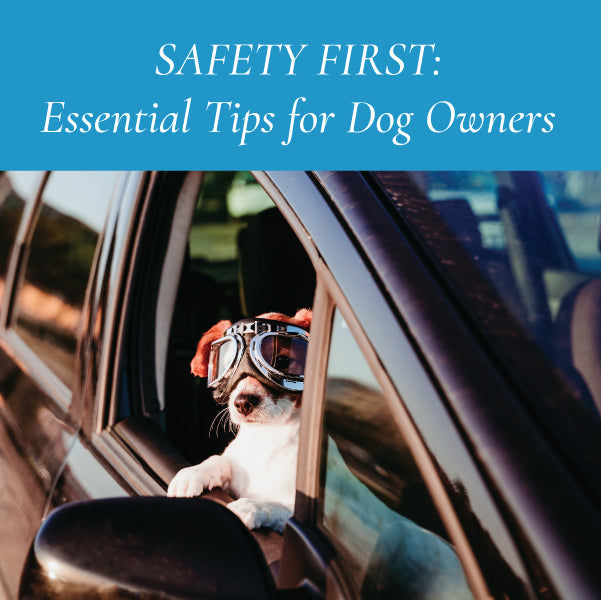Ensuring the safety of our furry companions is a top priority for every dog owner. Dogs are not just pets; they're family members, and their well-being affects our happiness and peace of mind. This blog post compiles essential safety tips for dog owners, drawing on advice from veterinary experts and animal welfare organizations. By following these guidelines, you can create a safer environment for your dog and prevent accidents and injuries.
1. Secure Your Home
Much like childproofing, dog-proofing your home is crucial to prevent curious canines from getting into trouble. This includes securing cabinets and trash cans, keeping toxic foods and plants out of reach, and removing small objects that could be swallowed.
Source: ASPCA's guide to pet-safe homes provides a comprehensive list of household hazards for pets.
2. Regular Vet Check-ups
Preventative healthcare is vital. Regular visits to the veterinarian for check-ups and vaccinations can prevent diseases and catch health issues before they become serious. An annual wellness exam is recommended for all dogs.
Source: The American Veterinary Medical Association emphasizes the importance of preventative care in maintaining your pet's health.
3. Proper Identification
A lost dog is a pet owner's nightmare. Ensure your dog wears a collar with an ID tag containing your contact information. Microchipping is also recommended as a more permanent form of identification.
Source: The American Kennel Club advocates for microchipping as an effective way to increase the chances of a lost pet's return.
4. Leash Training
Leashes protect your dog from traffic, wildlife, and other dangers. Leash training is essential for control in public spaces. Always use a sturdy leash and harness that's appropriate for your dog's size and strength.
Source: The Humane Society offers tips on choosing the right leash and harness and training your dog to walk nicely on a leash.
5. Dog-Proof Fencing
If you have a yard, ensuring it is securely fenced can prevent your dog from wandering off and protect them from other animals. Check regularly for gaps or weak points in your fencing.
Source: PetMD provides guidelines on selecting the best type of fencing for your dog based on breed and size.
6. Heat Safety
Never leave your dog in a car on a warm day, as temperatures can skyrocket quickly, leading to heatstroke. On hot days, limit exercise to cooler morning or evening hours and ensure they have access to shade and fresh water when outside.
Source: PETA outlines the dangers of leaving pets in hot cars and offers tips for keeping dogs cool in the summer heat.
7. Water Safety
Not all dogs are natural swimmers. Introduce your dog to water gradually and consider a life vest for pool, beach, or boating activities. Always supervise your dog around water.
Source: The American Red Cross provides safety tips for swimming with your dog, including how to introduce them to water safely.
8. Avoiding Toxic Substances
Be aware of foods, plants, and chemicals that are toxic to dogs. Common dangers include chocolate, xylitol (found in sugar-free gum), certain houseplants, and antifreeze.
Source: The ASPCA's Animal Poison Control Center offers a comprehensive list of toxic substances and what to do if your pet ingests something harmful.
9. Emergency Preparedness
Have a plan in place for emergencies, including natural disasters. This should include a pet emergency kit, knowing the location of the nearest 24-hour veterinary clinic, and having an evacuation plan that includes your pet.
Source: FEMA provides guidelines for pet owners on preparing for emergencies, including what to include in your pet's emergency kit.
10. Training and Socialization
Proper training and socialization are essential for your dog's safety and the safety of others. They can prevent behavioral issues and help your dog react calmly in new or stressful situations.
Source: The American Society for the Prevention of Cruelty to Animals (ASPCA) emphasizes the importance of early socialization and training for all dogs.
By taking proactive steps to ensure the safety of our dogs, we can protect them from many common dangers. Regular veterinary care, secure identification, and being mindful of the hazards in and around our homes can go a long way in keeping our beloved pets safe. Remember, the time and effort we put into ensuring our dogs' safety reflects our love and commitment to their well-being.
Sources
- ASPCA
- American Veterinary Medical Association
- American Kennel Club
- The Humane Society of the United States
- PetMD
- PETA
- American Red Cross
- FEMA
- American Society for the Prevention of Cruelty to Animals

